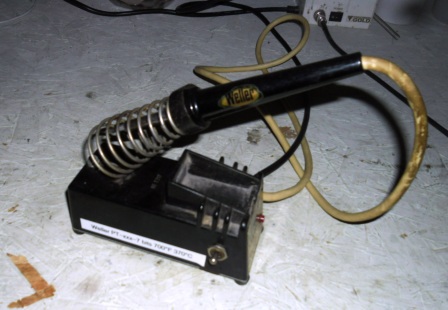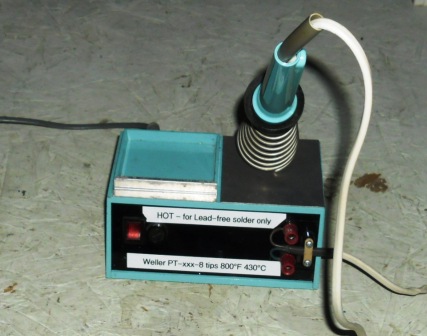Soldering Irons: Difference between revisions
Jump to navigation
Jump to search
| Line 6: | Line 6: | ||
The 'classic' temperature controlled bench soldering iron, used in industry for years, and replacement parts are still available. | The 'classic' temperature controlled bench soldering iron, used in industry for years, and replacement parts are still available. | ||
[[File:WSolderingIron_WellerBlack.JPG]] | |||
The Weller TCP irons use a unique temperature control mechanism, where the magnetic properties (Curie-point) of the bit itself control the point where the power to the iron is switched off. Each bit has a stamped in the end to denote the switching temperature, the black Weller should use number 7 bits, 700F / 370C suitable for leaded soldering. | The Weller TCP irons use a unique temperature control mechanism, where the magnetic properties (Curie-point) of the bit itself control the point where the power to the iron is switched off. Each bit has a stamped in the end to denote the switching temperature, the black Weller should use number 7 bits, 700F / 370C suitable for leaded soldering. | ||
Revision as of 12:02, 21 January 2014
| This page is a stub. You can help by expanding it! This page is included in the list of stub pages. |
More details and photos to follow Dclarke (talk) 04:47, 10 January 2014 (EST)
Black Weller
The 'classic' temperature controlled bench soldering iron, used in industry for years, and replacement parts are still available.
The Weller TCP irons use a unique temperature control mechanism, where the magnetic properties (Curie-point) of the bit itself control the point where the power to the iron is switched off. Each bit has a stamped in the end to denote the switching temperature, the black Weller should use number 7 bits, 700F / 370C suitable for leaded soldering.
Blue Weller
An updated version of the Black Weller, this one using number 8 bits, 800F / 425C more suitable for lead-free soldering.

